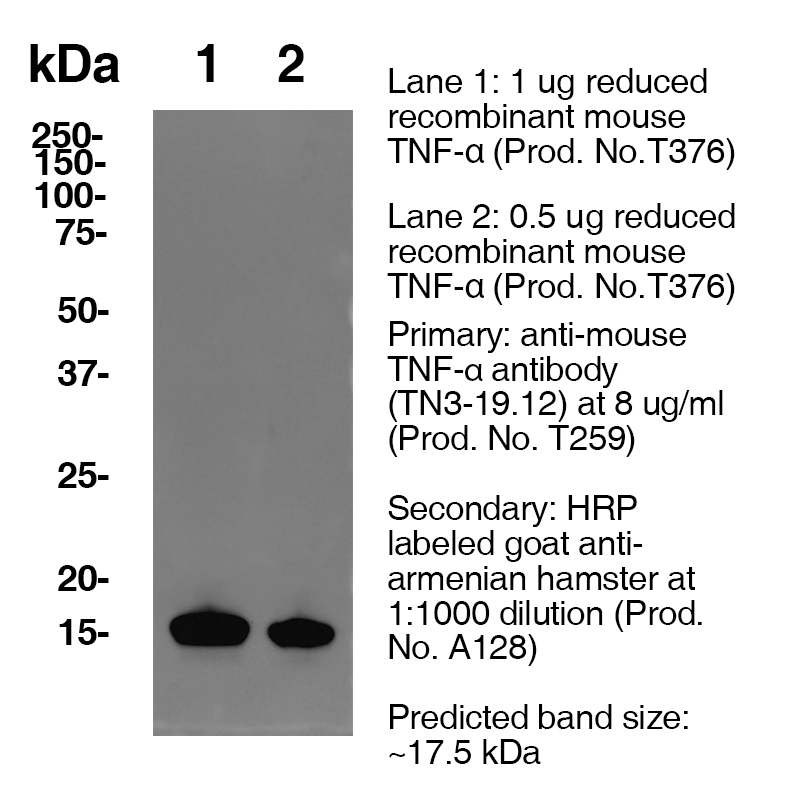Anti-Mouse TNF-α – Purified
Anti-Mouse TNF-α – Purified
Product No.: T259
- -
- -
Clone TN3-19.12 Target TNF-α Formats AvailableView All Product Type Monoclonal Antibody Alternate Names Tumor Necrosis Factor Ligand Superfamily Member 2 (TNFSF2), Cachectin, Differentiation-Inducing Factor (DIF), Necrosin, Cytotoxin Isotype IgG Applications ELISA , FC , WB |
Data
- -
- -
Antibody DetailsProduct DetailsReactive Species Mouse Host Species Armenian Hamster Immunogen E. coli-expressed, recombinant mouse TNF-α Product Concentration 0.5 mg/ml Formulation This purified antibody is formulated in 0.01 M phosphate buffered saline (150 mM NaCl) PBS pH 7.4, 1% BSA and 0.09% sodium azide as a preservative. Storage and Handling This purified antibody is stable when stored at 2-8°C. Do not freeze. Country of Origin USA Shipping Next Day Ambient RRIDAB_2831870 Applications and Recommended Usage? Quality Tested by Leinco ELISA: Each lot of this antibody is quality control tested by ELISA assay. For ELISA capture applications, a concentration range of 2 - 6 µg/ml is recommended. Western Blotting: Clone TN3-19.12, Anti-Mouse TNF-alpha can be used at a concentration of 0.8 µg/ml for western blotting applications. A suitable secondary antibody is Goat-Anti-Armenian Hamster-HRPO (PN:A128) (See Above Image). Each investigator should determine their own optimal working dilution for specific applications. See directions on lot specific datasheets, as information may periodically change. DescriptionDescriptionSpecificity Clone TN3-19.12 recognizes mouse TNFα. Background CD120 can refer to two members of the tumor necrosis factor receptor superfamily- CD120a (TNFR1) or CD120b (TNFR2). CD120a is a 55kD Type I transmembrane protein receptor that binds both TNF-α and TNF-β (LT-α). In association with TRADD and RIP, the receptor crosslinking induced by TNF-α or TNF-β trimers is vital for signal transduction, leading to apoptosis, NF-B activation, increased expression of proinflammatory genes, tumor necrosis, and cell differentiation depending on cell type and differentiation state. CD120b is a 75 kD type I transmembrane protein that binds both TNF-α and TNF-β. In conjunction with TRAF1 and TRAF2, the receptor crosslinking induced by TNF-α or TNF-β trimers is critical for signal transduction that may lead to apoptosis, NF-kB activation, increased expression of proinflammatory genes, tumor necrosis, and cell differentiation depending on cell type and differentiation state. TNF-α is a 17.5 kD protein that mediates inflammation and immunity caused by the invasion of viruses, bacteria, and parasites by initiating a cascade of cytokines that increase vascular permeability, thus bringing macrophages and neutrophils to the site of infection. TNF-α secreted by the macrophage causes the blood to clot which provides containment of the infection. TNF-α binding to surface receptors brings about various biologic activities that include cytolysis and cytostasis of many tumor cell lines In vitro, hemorraghic necrosis of tumors In vivo, increased fibroblast proliferation, and enhanced chemotaxis and phagocytosis in neutrophils. TNF-β (LT-α) is a 25 kD protein that has a significant impact on the maintenance of the immune system including the development of secondary lymphoid organs. TNF-β has dual functions. It may function to prevent growth of cancer cells or it may facilitate the development of tumors. TNF-β is involved in the regulation of cell survival, proliferation, differentiation, and apoptosis and, if unregulated, can result in a constantly active signaling pathway, resulting in uncontrolled cellular growth and creation of tumors. Additionally, TNF-β is involved in innate immune regulation and has been shown to prevent tumor growth and obliterate cancerous cell lines. Antigen Distribution TNF-α is secreted by macrophages, monocytes, neutrophils, T cells, B cells, NK cells, LAK cells. Research Area Immunology . Innate Immunity References & Citations1. El-Harith el-HA et al. (2004) Saudi Med J. 25: 135
2. Adolf GR et al. (1990) Infec Immun. 58: 3996 Technical ProtocolsCertificate of Analysis |



